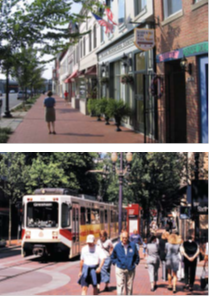Smart Growth and Heat Islands
While many factors contribute to heat island formation, several characteristics typical of urban areas significantly influence the existence of a heat island. Urban areas commonly have few trees and green spaces and are predominantly made up surfaces that are impervious or covered with buildings, thus leading to extreme temperatures. Roads, parking lots, and buildings are often constructed of materials that reflect less and absorb more of the sun’s energy. In addition, cities are typically designed to be dense and compact, which prevents adequate release of heat. Therefore, because urban design plays a large role in the creation of heat islands, smart growth development strategies provide an opportunity to reduce the heat island effect. When communities also incorporate cooling strategies into smart growth initiatives, they can realize multiple benefits more efficiently than pursuing these issues separately.
Smart growth practices cover a range of development and conservation strategies that help protect our natural environment and make our communities more attractive, livable, and economically vibrant.
Based on the experience of communities around the nation that have used smart growth approaches to create and maintain great neighborhoods, the Smart Growth Network developed a set of ten basic Smart Growth principles, as follows:
- Mix land uses, such as residential, commercial, and recreational uses
- Take advantage of compact building design
- Create a range of housing opportunities and choices
- Create walkable neighborhoods
- Foster distinctive, attractive communities with a strong sense of place
- Preserve open space, farmland, natural beauty, and critical environmental areas
- Strengthen and direct development towards existing communities
- Provide a variety of transportation choices
- Make development decisions predictable, fair, and cost effective
- Encourage community and stakeholder collaboration in development decisions

Heat island cooling strategies can incorporate these smart growth principles. For example, planting trees and vegetation and promoting parks and open space throughout developed areas can simultaneously result in mixed land uses, more attractive communities, and preserved natural beauty. Local heat island initiatives can incorporate community and stakeholder collaboration in decisions on appropriate strategies, which helps to foster a stronger community as a whole.
Conversely, smart growth initiatives can incorporate any or all of the main heat island cooling strategies – trees and vegetation, green roofs, cool roofs, and cool pavements, as illustrated in the following examples. When developing new smart growth areas, local officials and developers can incorporate green and cool roofs into the design of residential and commercial buildings. These roof designs help to lower energy costs and allow continued use of existing buildings. Planting trees and adding green spaces not only reduces temperatures inside and outside buildings, but can also enhance the attractiveness and distinctiveness of a community. Streets, alleys, parking lots, sidewalks, and other surfaces can be constructed using permeable/pervious paving materials, helping to cool a community while also reducing stormwater runoff which can increase its walkability.
By combining smart growth and urban cooling strategies, communities can address heat islands while enhancing the quality and character of their neighborhoods.
Visit EPA’s Smart Growth site for more information about specific smart growth strategies.
